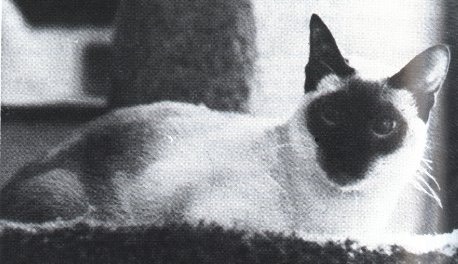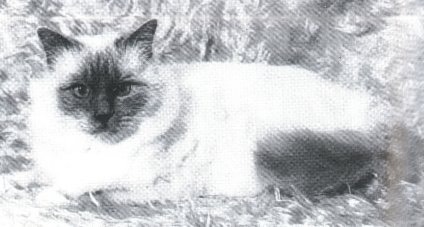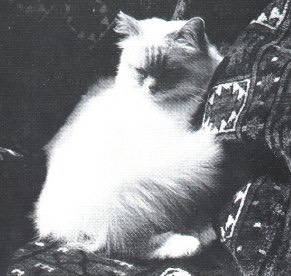History of Color Creation

Color Creation dates
1924-1958: Seal-Point only
1959: Blue-Point
1977: Chocolate-Point & Lilac-Point
Codes: SBI: Sacré de Birmanie = Birman
1. SEAL-POINT - Code SBI n:
The First Birman (in the 1920s) came from siamese lines that were seal-point [black cats with the siamese gene that only colors the cold body extremities and leaves the rest (the warmer parts) white] and direct descendant of the first Siamese imported from Thailand at the end of the nineteenth century and at the dawn of the twentieth century. It is well recorded, in Siamese catteries, that random siamese kittens were born with long hair (what we call today Balinese or Javanese) from short hair parents. They were usually eliminated as undesirable (cf. History of the Balinese cats if you wish to know more). Important breeders of the first times were Mrs Arlette Poirier (de Crespières) and Mrs Gamichon (des Grandes Chapelles) who founded in 1961 the Cercle Sacré du Chat Sacré de Birmanie et du Persan Colourpoint.
2. BLUE-POINT - Code SBI a:
In 1955, the first Birman carrier of the blue gene was Éloi-Eryx de Madalpour (Mrs Chaumont-Doisy). At the end of the 1950s, the French cattery des Muses used a Blue Persan (Bluette de la Côte d’Azur) to create the new Blue-Point color (a dilution factor of the seal-point). The result was Iris du Clos Fleuri (1959-08-21) in France. In United Sates (Tacoma, Washington), one of the first and most famous blue-point (found in many pedigrees) was Griswold’s Burman Boi Bleu (1964-10-12) [Owned by Mrs Gertrude Griswold. She later changed her cattery name into Clover Creek]. One of his famous blue-point grand-daughter was Ghandi von Assindia, a German cat imported in England by Mrs Fisher (Praha Cattery).
- CHOCOLATE-POINT - Code SBI b - LILAC-POINT - Code SBI c:
In the 1970s the United Kingdom became the main production center of the new colors. Quarantine laws (6 months) forced breeders to work in closed circuit. The first new creation was the Chocolate-Point and its dilution companion, the Lilac-Point.
Circa 1975*, two catteries began to work hand in hand in a scholarly way, to produce a Birman with the chocolate-point/lilac-point pattern. In order to do so, they used two breeds beside the existing Birman: the Colorpoint (Himalayan) Persian for the lilac side and the Siamese for the chocolate side. This choice had the advantage to preserve the blue eyes , the long hair genes, and (via the siamese) the silky coat version. These two catteries are:
-Shwechinthe Cattery (Dr. Elizabeth Brigliadori in Charlbury, Oxfordshire, UK). We should also add here the indispensable previous work of Mingchiu Cattery (Mrs. J. P. Harding one of the two founders of Colorpoint Persians (Himalayans)).
-Mandessa Cattery (Mrs Shirley Wilson-Smith).
*(The color was only recognized by the GCCF in 1993.)
How did they do it?
(Give to Cesar what belongs to Cesar!)
- 1975: Recessive Genes. The Shwechinthe cattery used a colorpoint lilac persan: Mingchiu Manakini (1971-08-19) (from a colorpoint chocolate persan sire and a lilac persan dam) and a blue-point Birman (Ambur Blue Thongwa)*, to create a male: Shwechinthe Mandessa (1975-08-10), an in-between blue cat (lilac carrier).
* From the German Ghandi von Assindia Line.
MALE
Colorpoint Persan Lilac + Blue-Point Birman = Blue Cat (+gene c)
Mingchiu Manakini + Ambur Blue Thongwa = Shwechinthe Mandessa

Mingchui Manakini (Persan Colorpoint lilac-point)
- 1976: Dominant Genes. The Mandessa cattery used a chocolate siamese: Dear Dominic (1970-03-22) and a seal-point Birman (Cragland Darlene) to create the in-between black female cat Mandessa Abygail (1976-05-11) (chocolate carrier).
FEMALE
Siamese Chocolate sire + Seal-Point Birman dam = Seal Cat (gene b)
Dear Dominic + Cragland Darlene = Mandessa Abygail -FEMALE

Dear Dominic (Siamese - chocolate Point)
Note: This work and combination respected harmoniously the origin of the Birman; the work of previous French breeders generations, and kept the type of the Birman similar (coming on one side from Persan Himalayan cats and on the other from Siamese cats). It was also smart to use a seal and a blue line on the Birman side to be sure they would produce those in their lines. This also had the advantage to add two new genetic pools together: the lilac and the chocolate lines. 50% of these cats were made of a new genetic pool for the Birman breed, thus renewing the blood.
- 1977: The two were wed together in Spring 1977 to create the first cats with 4 possible colors in July:
Blue Cat (gene a + c) + Seal Cat (gene n + b) = Chocolate-Point Birman (gene b + c)
Shwechinthe Mandessa + Mandessa Abygail = Mandessa Bianca & Mandessa Brita (FEMALE)
c.1. The first important chocolate female created on the Mandessa side was Mandessa Bianca (1977-05-30) and then Mandessa Brita (1977-07-20)
c.2 To diversify the line, Shwechinthe used also another combination. A chocolate colorpoint persan cat named Mingchiu Nobbi (1975-07-10) was wed with another Seal-Point Birman (Cragland Ionne). It created a new in-between chocolate-point male, cat, Shwechinthe Aero (1977-05-30).
Blue Colorpoint Persan + Seal-Point Birman = Chocolate-Point Cat
Mingchiu Nobbi + Cragland Ionne = Shwechinthe Aero (MALE).
c.3 the two lines were wed together to create the new Birman chocolate generations
MANDESSA BIANCA & MANDESSA BRITA + SHWECHINTHE AERO
From this combination came the 4th generation:
a. On the Mandessa side with Bianca: Mandessa Coral (1979-05-31)
- On the Shwechinthe side with Brita: Shwechinthe Maidenless Coco, Cabora, Topaz and Candice (Lilac) (we only mention cats who had an offspring). These cats can be find in today pedigrees of chocolate and lilac Birmans.
Note: This research work is based on a study of the Birman pedigrees archives.
Pictures of the first Chocolate and Lilac Birmans

Shwechinthe Akyab (Lilac)

Shwechinthe Kybo (chocolate)

Swechinthe Mayo (Choco) & Aliny (lilac)

Swechinthe Tuzu (lilac)